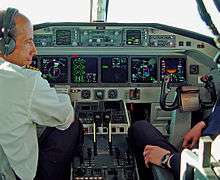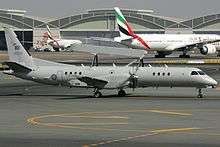Saab 2000
| Saab 2000 | |
|---|---|
 | |
| Darwin Airline Saab 2000 in Etihad Regional livery taking off at Düsseldorf Airport in 2014 | |
| Role | Passenger aircraft |
| Manufacturer | Saab |
| First flight | 26 March 1992 |
| Introduction | 30 August 1994 |
| Status | In service |
| Primary users | Braathens Regional Darwin Airline Eastern Airways Loganair |
| Produced | 1992–99 |
| Number built | 63[1] |
| Developed from | Saab 340 |
The Saab 2000 is a twin-engined high-speed turboprop airliner built by Saab. It is designed to carry 50–58 passengers and cruise at a speed of 665 km/h (413 mph). Production took place in Linköping in southern Sweden. The Saab 2000 first flew in March 1992 and was certified in 1994. The last aircraft was delivered in April 1999, a total of sixty-three aircraft being built and thirty-three remaining in service as of July 2013.[1]
Development and Design
In December 1988, Saab decided to build a stretched derivative of its successful Saab 340 twin-turboprop regional airliner. The new aircraft was planned to meet a perceived demand for a high-speed 50-seat turboprop with good climb performance which could operate over short- and medium-range routes with similar block times to jet aircraft while retaining the efficiency provided by turboprop engines.[2] The new airliner, called the Saab 2000, was formally launched in May 1989, with Saab already having firm orders for 46 aircraft and options for a further 147.[3] The aircraft was assembled at Saab's Linköping factory, with major subcontractors including CASA, who built the aircraft's wings, Short Brothers, who built the rear fuselage and Valmet who built the aircraft's tail surfaces.[4] The Saab 2000 first flew on 26 March 1992 and entered into scheduled airline service in September 1994, a few months after its certification by the Joint Aviation Authorities in March and the Federal Aviation Administration in April.[5][6]
The Saab 2000 has a 15% greater wingspan than the Saab 340,[3] and being 7.55 metres (24 ft 9 in) longer can carry up to 58 passengers in a high-density layout and 50 with a more comfortable 32 inches (81 cm) seat pitch.[7][2] The 2000 was the first commercial aircraft to use the 4,591shp Rolls-Royce AE 2100 turboprop engines (then built by Allison), driving slow turning six-bladed Dowty Rotol propellers. One engine was mounted on each wing, as in the 340, with the engines placed further from the fuselage than those of the 340 to reduce cabin noise.[3]
Operational history

Sales of the Saab 2000 were fairly limited. The major initial customer was Crossair, a regional airline which had Swissair as a 56% shareholder. Crossair took delivery of 34 aircraft and was still operating the type in 2005. Due to limited demand, Saab ceased production of the Saab 2000 in 1999, with the last aircraft being delivered to Crossair on 29 April of that year.[8] General Motors (GM) operated several corporate-configured Saab 2000s and was in talks with new startup air carrier Pro Air to have this airline operate them in scheduled service as Pro Air Express in the U.S.; however, Pro Air then encountered financial difficulties and ceased all operations before the deal could be consummated. Air Marshall Islands also operated a Saab 2000 in the remote Micronesia island region of the Pacific Ocean.
By the year 2013, 57 Saab 2000 aircraft remained in service. The primary reason for the low sales was the success of newly introduced regional jets such as the Bombardier CRJ and Embraer ERJ 145 family which provided better performance and passenger comfort for the same initial price. Some smaller airlines, including Eastern Airways in the UK, have subsequently acquired 2000s at low cost and operated them on regional routes which experience lower passenger numbers as well on shuttle services in the U.K. for oil and gas personnel working in the North Sea.
In June 2006, Pakistan completed the purchase of six Saab 2000 turboprop aircraft to be equipped with the Saab-Ericsson ERIEYE Airborne Early Warning system. Revised in May 2007 due to renegotiation with the Government of Pakistan, only five aircraft will be delivered, four of which will be equipped with the Erieye system. On 3 April 2008, the first Saab 2000 Erieye AEW&C was rolled out and presented to Pakistan Air Force officials during a ceremony in Sweden.[9]
Variants
- Saab 2000: 50–58 seat regional airliner.
- Saab 2000FI: Flight inspection aircraft for the Japan Civil Aviation Bureau, two produced.
- Saab 2000 AEW&C: Airborne early warning and control variant fitted with Erieye active electronically scanned array radar and associated mission systems.
- Saab 2000 Airtracer: SIGINT aircraft
- Saab 2000 MPA: Maritime patrol aircraft
Operators
Civilian operators

As of July 2016, a total of 35 Saab 2000s remained in airline service,[10] operated by:
- Braathens Regional (9)[10]
- Etihad Regional (7)[10]
- Eastern Airways (7)[10]
- Loganair (5)[10]
- PenAir (5)[10]
- BA CityFlyer(2)[10]
- SkyWork Airlines(2)[10]
Military operators

Specifications
Data from Brassey's World Aircraft & Systems Directory 1999/2000[5]
General characteristics
- Crew: two
- Capacity: 50–58 passengers
- Payload: 5,900 kg (13,010 lb)
- Length: 27.28 m (89 ft 6 in)
- Wingspan: 24.76 m (81 ft 3 in)
- Height: 7.73 m[11] (25 ft 4 in)
- Wing area: 55.7 m² (600 sq ft)
- Airfoil: NASA MS(1)013
- Aspect ratio: 11:1
- Empty weight: 13,800 kg (30,424 lb)
- Max. takeoff weight: 22,800 kg (50,265 lb)
- Powerplant: 2 × Allison AE 2100A turboprop, 3,096 kW (4,152 shp) each
- Propellers: six blade constant speed Dowty propellers, 1 per engine
Performance
- Cruise speed: 665 km/h (370 knots, 424 mph)
- Range: 2,869 km (1,549 nmi, 1,782 mi) at long range cruise
- Service ceiling: 9,450 m (31,000 ft)
- Rate of climb: 11.4 m/s (2,250 ft/min)
Avionics
- Rockwell Collins Pro Line 4 avionics suite with integrated avionics processor (IAP)
Accidents and incidents
- On 10 July 2002, Crossair Flight 850, a Saab 2000, was forced to make an emergency landing at Werneuchen Airfield, Germany, as a result of severe weather. One of the sixteen passengers on board suffered minor injuries. The aircraft, registered as HB-IZY, was damaged beyond economic repair when it hit an earth bank placed across the runway, the markings of which did not conform to standards.[12]
See also
- Related development
- Aircraft of comparable role, configuration and era
- Antonov An-24/Xian Y-7/Xian MA60
- Antonov An-140
- ATR 72
- BAe ATP
- Bombardier Dash 8 Series 300
- CASA/IPTN CN-235
- CASA 3000
- Dornier 328
- Fokker 50
- Ilyushin Il-114
- Related lists
References
- Citations
- 1 2 "2013 World Airliner Census", p. 58.
- 1 2 Wheeler Air International February 1993, p. 65.
- 1 2 3 Wheeler Air International February 1993, p. 66.
- ↑ Lambert 1993, pp. 351, 355.
- 1 2 Taylor 1999, p. 232.
- ↑ Moxon, Julian. "Crossair is pleased with Saab 2000 in service". Flight International, Volume 146, Number 4443, 19–25 October 1994, p. 10. ISSN 0015-3710
- ↑ Taylor 1999, pp 231–232.
- ↑ "Commercial Aircraft Directory - Saab 2000". Flightglobal. Archived from the original on 17 March 2013.
- ↑ Update, Defense. "Saab Debut '2000 Special Mission Aircraft at Farnborough".
- 1 2 3 4 5 6 7 8 Thisdell and Fafard Flight International 9–15 August 2016, p. 42.
- ↑ Lambert 1993, p.356.
- ↑ "Report: Crossair SB20 at Werneuchen on Jul 10th 2002, landed before runway and impacted earth wall". Avherald.com. Retrieved 2013-04-14.
- Bibliography
- Lambert, Mark. Jane's All The World's Aircraft 1993–94. Coulsdon, UK: Jane's Data Division, 1993. ISBN 0-7106-1066-1.
- Taylor, Michael J. H. Brassey's World Aircraft & Systems Directory 1999/2000. London: Brassey's, 1999. ISBN 1-85753-245-7.
- Thisdell, Dan and Fafard, Antoine. "World Airliner Census". Flight International, Volume 190, No. 5550, 9–15 August 2016. pp. 20–43. ISSN 0015-3710
- Wheeler, Barry. "SAAB 2000: An exercise in growth and commonality" Air International, Volume 44, Number 2, February 1993. pp. 65–70. ISSN 0306-5634
- "World Airliner Census". Flight International, Volume 184, Number 5403, 13–19 August 2013, pp. 40–58.
Further reading
- Magnusson, Michael. Saab 340 & Saab 2000 – The Untold Story. Stockholm, Sweden: Aviatic Förlag, 2014. ISBN 978-9186642-051
External links
| Wikimedia Commons has media related to Saab 2000. |